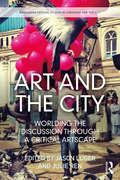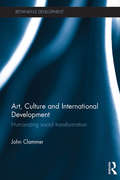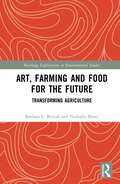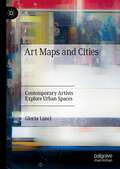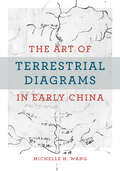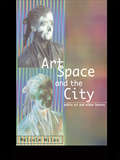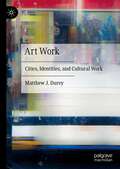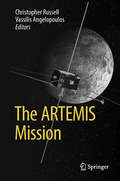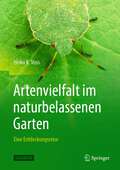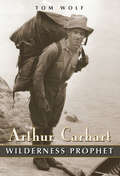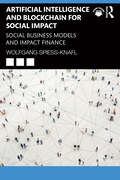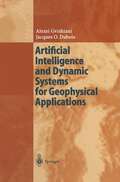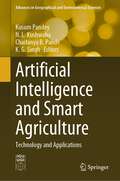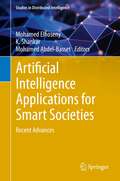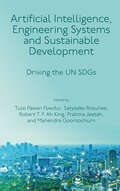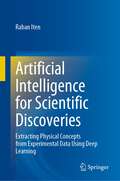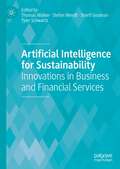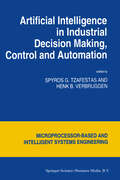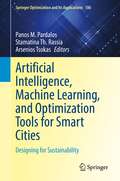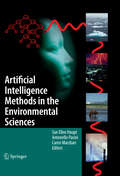- Table View
- List View
Art and the City: Worlding the Discussion through a Critical Artscape (Routledge Critical Studies in Urbanism and the City)
by Jason Luger Julie RenArtistic practices have long been disturbing the relationships between art and space. They have challenged the boundaries of performer/spectator, of public/private, introduced intervention and installation, ephemerality and performance, and constantly sought out new modes of distressing expectations about what is construed as art. But when we expand the world in which we look at art, how does this change our understanding of critical artistic practice? This book presents a global perspective on the relationship between art and the city. International and leading scholars and artists themselves present critical theory and practice of contemporary art as a politicised force. It extends thinking on contemporary arts practices in the urban and political context of protest and social resilience and offers the prism of a ‘critical artscape’ in which to view the urgent interaction of arts and the urban politic. The global appeal of the book is established through the general topic as well as the specific chapters, which are geographically, socially, politically and professionally varied. Contributing authors come from many different institutional and anti-institutional perspectives from across the world. This will be valuable reading for those interested in cultural geography, urban geography and urban culture, as well as contemporary art theorists, practitioners and policymakers.
Art, Culture and International Development: Humanizing social transformation (Rethinking Development)
by John ClammerCulture is not simply an explanation of last resort, but is itself a rich, multifaceted and contested concept and set of practices that needs to be expanded, appreciated and applied in fresh ways if it is to be both valued in itself and to be of use in practical development. This innovative book places culture, specifically in the form of the arts, back at the centre of debates in development studies by introducing new ways of conceptualizing art in relation to development. The book shows how the arts and development are related in very practical ways – as means to achieve development goals through visual, dramatic, filmic and craft-inspired ways. It advocates not so much culture and development, but rather for the development of culture. Without a cultural content to economic and social transformation the problems found in much development – up-rooting of cultures, loss of art forms, languages and modes of expression and performance – may only accelerate. Paying attention to the development of the arts as the content of development helps to amend this culturally destructive process. Finally, the book argues for the value of the arts in attaining sustainable cultures, promoting poverty alleviation, encouraging self-empowerment, stimulating creativity and the social imagination, which in turn flow back into wider processes of social transformation. Discussion questions at the end of each chapter make this book ideal to help foster further thinking and debate. This book is an inspiring read for postgraduate students and researchers in the fields of development studies, cultural studies and sociology of development.
Art, Culture and International Development: Humanizing social transformation (Rethinking Development)
by John ClammerCulture is not simply an explanation of last resort, but is itself a rich, multifaceted and contested concept and set of practices that needs to be expanded, appreciated and applied in fresh ways if it is to be both valued in itself and to be of use in practical development. This innovative book places culture, specifically in the form of the arts, back at the centre of debates in development studies by introducing new ways of conceptualizing art in relation to development. The book shows how the arts and development are related in very practical ways – as means to achieve development goals through visual, dramatic, filmic and craft-inspired ways. It advocates not so much culture and development, but rather for the development of culture. Without a cultural content to economic and social transformation the problems found in much development – up-rooting of cultures, loss of art forms, languages and modes of expression and performance – may only accelerate. Paying attention to the development of the arts as the content of development helps to amend this culturally destructive process. Finally, the book argues for the value of the arts in attaining sustainable cultures, promoting poverty alleviation, encouraging self-empowerment, stimulating creativity and the social imagination, which in turn flow back into wider processes of social transformation. Discussion questions at the end of each chapter make this book ideal to help foster further thinking and debate. This book is an inspiring read for postgraduate students and researchers in the fields of development studies, cultural studies and sociology of development.
Art, Farming and Food for the Future: Transforming Agriculture (Routledge Explorations in Environmental Studies)
by Barbara L. Benish Nathalie BlancThis book explores the impact of artistic experiments in inspiring people to turn away from current food consumerism and take an active role in preserving, sustaining, and protecting the environment. As artists are expanding their practice into social justice and community concerns, erasing traditional forms of expression and integrating others, the culture around food and its production has been added to a new vocabulary of experiential art. The authors measure the impact of such experiments on local food consumption and production, focusing on education and youth, both in the surrounding community and culture at large. They suggest how these projects can be up-scaled to further encourage sustainable solutions for our environment and communities. The book explores the reflections and motivations of case study practitioners in urban and rural areas and, through interviews, engages with artists who are pioneering a new trend to create hubs of activity away from traditional art spaces in cities to follow a non-hierarchal practice that is de-centralized and communally based. This book will be of great interest to academic readers concerned with issues related to environmental aesthetics, eco-design, eco-criticism, culture, heritage, memory, and identity, and those interested in the current debates on the place of aesthetics and culture in sustainability.
Art, Farming and Food for the Future: Transforming Agriculture (Routledge Explorations in Environmental Studies)
by Barbara L. Benish Nathalie BlancThis book explores the impact of artistic experiments in inspiring people to turn away from current food consumerism and take an active role in preserving, sustaining, and protecting the environment. As artists are expanding their practice into social justice and community concerns, erasing traditional forms of expression and integrating others, the culture around food and its production has been added to a new vocabulary of experiential art. The authors measure the impact of such experiments on local food consumption and production, focusing on education and youth, both in the surrounding community and culture at large. They suggest how these projects can be up-scaled to further encourage sustainable solutions for our environment and communities. The book explores the reflections and motivations of case study practitioners in urban and rural areas and, through interviews, engages with artists who are pioneering a new trend to create hubs of activity away from traditional art spaces in cities to follow a non-hierarchal practice that is de-centralized and communally based. This book will be of great interest to academic readers concerned with issues related to environmental aesthetics, eco-design, eco-criticism, culture, heritage, memory, and identity, and those interested in the current debates on the place of aesthetics and culture in sustainability.
Art Maps and Cities: Contemporary Artists Explore Urban Spaces
by Gloria LanciThis book presents an original study on how contemporary artists are exploring urban spaces through mapping. Despite a long history of representations of cities in maps, and the relationships that can be envisaged between art maps and cities in the contemporary world, little research is dedicated to investigating how artists intervene in the realm of urban cartography. The research examines a century-old history of art maps and draws on academic debates challenging traditional notions of maps as scientific artefacts produced through accurate measurement and surveying. The potential of art maps to construct personal narratives, through contestation, embodiment and play, is analysed in the city context, where spaces are shaped by urban planning and design, political ideologies and socio-economic forces. Adopting an exploratory and interpretative research approach that investigates the confluence of theories originated in different domains, this book conducts the reader to discover what artistic practices can bring into a more creative, while inquisitive, understanding of cities. A series of semi-structured interviews with visual artists, enquiring how they apprehend, process and re-create urban spaces in artworks, explores cartographic process and methods in visual art practices in the twenty first century, which incorporates digital technologies and critical thinking.
The Art of Terrestrial Diagrams in Early China
by Michelle H. WangA study of early Chinese maps using interdisciplinary methods. This is the first English-language monograph on the early history of maps in China, centering on those found in three tombs that date from the fourth to the second century BCE and constitute the entire known corpus of early Chinese maps (ditu). More than a millennium separates them from the next available map in the early twelfth century CE. Unlike extant studies that draw heavily from the history of cartography, this book offers an alternative perspective by mobilizing methods from art history, archaeology, material culture, religion, and philosophy. It examines the diversity of forms and functions in early Chinese ditu to argue that these pictures did not simply represent natural topography and built environments, but rather made and remade worlds for the living and the dead. Wang explores the multifaceted and multifunctional diagrammatic tradition of rendering space in early China.
Art, Space and the City
by Malcolm MilesPublic art - the making, management and mediation of art outside its conventional location in museums and galleries, and the livable city - a concept involving user-centred strategies for urban planning and design, are both socially produced but have emerged from different fields and tend to be discussed in isolation.This book applies a range of critical perspectives which have emerged from different disciplines - art criticism, urban design, urban sociology, geography and critical theory - to examine the practice of art for urban public spaces, seeing public art from positions outside those of the art world to ask how it might contribute to possible urban futures. Exploring the diversity of urban politics, the functions of public space and its relation to the structures of power, the roles of professionals and users in the construction of the city, the gendering of space and the ways in which space and citizen are represented, the book explains how these issues are as relevant to architecture, urban design and urban planning as they are to public art. Drawing on a wealth of images from across the UK and Europe and the USA, in particular, the author questions the effectiveness of public art in achieving more convivial urban environments, whilst retaining the idea that imagining possible futures is as much part of a democratic society as using public space.
Art, Space and the City
by Malcolm MilesPublic art - the making, management and mediation of art outside its conventional location in museums and galleries, and the livable city - a concept involving user-centred strategies for urban planning and design, are both socially produced but have emerged from different fields and tend to be discussed in isolation.This book applies a range of critical perspectives which have emerged from different disciplines - art criticism, urban design, urban sociology, geography and critical theory - to examine the practice of art for urban public spaces, seeing public art from positions outside those of the art world to ask how it might contribute to possible urban futures. Exploring the diversity of urban politics, the functions of public space and its relation to the structures of power, the roles of professionals and users in the construction of the city, the gendering of space and the ways in which space and citizen are represented, the book explains how these issues are as relevant to architecture, urban design and urban planning as they are to public art. Drawing on a wealth of images from across the UK and Europe and the USA, in particular, the author questions the effectiveness of public art in achieving more convivial urban environments, whilst retaining the idea that imagining possible futures is as much part of a democratic society as using public space.
Art Work: Cities, Identities, and Cultural Work
by Matthew J. DureyThis book is about the relationship between art and work in the cultural economy. It is an exploration of the experiences of people working in cultural and creative industries, and of the importance of place, identity, and culture in postindustrial society. Drawing on fieldwork exploring the conditions of cultural work, identity, and postindustrial cities in Newcastle upon Tyne, UK and Hamburg, Germany, the book argues that the conditions of work in the cultural economy are the result of a contradictory tension between art and economy, which manifests in various ways in artists’ conditions of work, their identities, and their relationship to the changing landscapes of postindustrial cities. This is explored through a series of stories from people working in cultural and creative industries, in which they highlight significant contradictions, obstacles, and opportunities in negotiating the cultural economy, casting light on the importance of art and culture in postindustrial society.
The ARTEMIS Mission
by Christopher Russell Vassilis AngelopoulosThe ARTEMIS mission was initiated by skillfully moving the two outermost Earth-orbiting THEMIS spacecraft into lunar orbit to conduct unprecedented dual spacecraft observations of the lunar environment. ARTEMIS stands for Acceleration, Reconnection, Turbulence and Electrodynamics of the Moon's Interaction with the Sun. Indeed, this volume discusses initial findings related to the Moon’s magnetic and plasma environments and the electrical conductivity of the lunar interior. This work is aimed at researchers and graduate students in both heliophysics and planetary physics. Originally published in Space Science Reviews, Vol. 165/1-4, 2011.
Artenvielfalt im naturbelassenen Garten: Eine Entdeckungsreise
by Heiko K. VossDieses Buch nimmt Sie mit auf eine Gartenerkundung der besonderen Art: In außergewöhnlichen Fotos und persönlichen Texten berichtet der Autor von staunenswerten Entdeckungen in Flora und Fauna, die er in seinem naturbelassenen Garten macht. Durch enthaltsames Gärtnern hat sich dort nach nur wenigen Jahren eine beeindruckende Biodiversität eingestellt, welche der Autor durch die Jahreszeiten hindurch dokumentiert. Ein Gartenrundgang auf Du und Du mit der Natur, der die Augen öffnet für eine wundersame Welt im Kleinen und Lust macht, im eigenen Garten Lebensräume für die Tierwelt zu gestalten!
Arthur Carhart: Wilderness Prophet
by Tom WolfArthur Carhart (1892 -1978), America's first champion of wilderness, the first Forest Service landscape architect, and the most popular conservation writer of mid-century America, won none of the titan status of his contemporary Aldo Leopold. A political maverick, he refused to side with any major advocacy group and none has made him its saint. Carhart was a grassroots thinker in a top-down era. Arthur Carhart, the first biography of this Republican environmentalist and major American thinker, writer, and activist, reveals the currency of his ideas. Tom Wolf elucidates Carhart 's vision of conservation as "a job for all of us," with citizens, municipal authorities, and national leaders all responsible for the environmental effects of their decisions. Carhart loved the local and decried interest groups - from stockmens' associations to wilderness lobbies - as cliques attempting blanket control. He pressured land management agencies to base decisions on local ecology and local partnerships. A lifelong wilderness advocate who proposed the first wilderness preserve at Trappers Lake, Colorado, in 1919, Carhart chose to oppose the Wilderness Act, heartsick at its compromises with lobbies. Because he shifted his stance and changed his views in response to new information, Carhart is not an easy subject for a biography. Wolf traces Carhart's twists and turns to show a man whose voice was distinctive and contrary, who spoke from a passionate concern for the land and couldn't be counted on for anything else. Readers of American history and outdoor writing will enjoy this portrait of a historic era in conservation politics and the man who so often eschewed politics in favor of the land and people he loved.
Artificial Intelligence and Blockchain for Social Impact: Social Business Models and Impact Finance
by Wolfgang Spiess-KnaflArtificial Intelligence and Blockchain for Social Impact provides an accessible overview of artificial intelligence (AI) and blockchain technologies, and explores their applications for social enterprise and impact investing. The opening chapter introduces the impact space, exploring different social business models, the role of technology, the impact investing market and general problems in the space. The remainder of this book falls into two paths: the first focusing on AI and the other looking at the blockchain technology. Providing introductions to each of these technologies and their histories, the author goes on to examine them from the perspectives of social business models and impact finance. A concluding chapter explores AI and cryptocurrencies in the impact space in the future. Readers are supported with international case studies and other student-friendly features. Situated at the intersection between technology, fintech, social enterprise, impact investing and social impact, this book is a valuable resource for upper-level courses across all these areas. It also offers an introduction to this emerging topic for researchers and business professionals. Online teaching resources to accompany this book include instructor lecture slides and data sets.
Artificial Intelligence and Blockchain for Social Impact: Social Business Models and Impact Finance
by Wolfgang Spiess-KnaflArtificial Intelligence and Blockchain for Social Impact provides an accessible overview of artificial intelligence (AI) and blockchain technologies, and explores their applications for social enterprise and impact investing. The opening chapter introduces the impact space, exploring different social business models, the role of technology, the impact investing market and general problems in the space. The remainder of this book falls into two paths: the first focusing on AI and the other looking at the blockchain technology. Providing introductions to each of these technologies and their histories, the author goes on to examine them from the perspectives of social business models and impact finance. A concluding chapter explores AI and cryptocurrencies in the impact space in the future. Readers are supported with international case studies and other student-friendly features. Situated at the intersection between technology, fintech, social enterprise, impact investing and social impact, this book is a valuable resource for upper-level courses across all these areas. It also offers an introduction to this emerging topic for researchers and business professionals. Online teaching resources to accompany this book include instructor lecture slides and data sets.
Artificial Intelligence and Dynamic Systems for Geophysical Applications
by Alexej Gvishiani Jacques O. DuboisThe book presents new clustering schemes, dynamical systems and pattern recognition algorithms in geophysical, geodynamical and natural hazard applications. The original mathematical technique is based on both classical and fuzzy sets models. Geophysical and natural hazard applications are mostly original. However, the artificial intelligence technique described in the book can be applied far beyond the limits of Earth science applications. The book is intended for research scientists, tutors, graduate students, scientists in geophysics and engineers
Artificial Intelligence and Smart Agriculture: Technology and Applications (Advances in Geographical and Environmental Sciences)
by Kusum Pandey N. L. Kushwaha Chaitanya B. Pande K. G. SinghAs technology continues to saturate modern society, agriculture has started to adopt digital computing and data-driven innovations. This emergence of “smart” farming has led to various advancements in the field, including autonomous equipment and the collection of climate, livestock, and plant data. As connectivity and data management continue to revolutionize the farming industry, empirical research is required to understand these technological developments. This book explores the applications of various artificial intelligence techniques by identifying and describing technical, functional, and non-functional future technologies for smart farming and agriculture. The book also presents practical application opportunities for the resolution of real-world problems, including contributions from precision irrigation, greenhouse data, livestock monitoring, automation, IoT ecosystems for agriculture, cloud computing, mobile robots for precision agriculture, remote sensing applications, anddata mining. In addition, this book provides summary information about different soilless techniques such as hydroponics, aeroponics, and aquaponics, among others. This book is ideally designed for farmers, agriculturalists, product managers, farm holders, manufacturers, equipment suppliers, industrialists, governmental professionals, researchers, academicians, and students seeking current research on technological applications within agriculture and farming.
Artificial Intelligence Applications for Smart Societies: Recent Advances (Studies in Distributed Intelligence)
by Mohamed Elhoseny K. Shankar Mohamed Abdel-BassetThis volume discusses recent advances in Artificial Intelligence (AI) applications in smart, internet-connected societies, highlighting three key focus areas. The first focus is on intelligent sensing applications. This section details the integration of Wireless Sensing Networks (WSN) and the use of intelligent platforms for WSN applications in urban infrastructures, and discusses AI techniques on hardware and software systems such as machine learning, pattern recognition, expert systems, neural networks, genetic algorithms, and intelligent control in transportation and communications systems. The second focus is on AI-based Internet of Things (IoT) systems, which addresses applications in traffic management, medical health, smart homes and energy. Readers will also learn about how AI can extract useful information from Big Data in IoT systems. The third focus is on crowdsourcing (CS) and computing for smart cities. this section discusses how CS via GPS devices, GIS tools, traffic cameras, smart cards, smart phones and road deceleration devices enables citizens to collect and share data to make cities smart, and how these data can be applied to address urban issues including pollution, traffic congestion, public safety and increased energy consumption. This book will of interest to academics, researchers and students studying AI, cloud computing, IoT and crowdsourcing in urban applications.
Artificial Intelligence, Engineering Systems and Sustainable Development: Driving the UN SDGs
by Tulsi Pawan Fowdur Satyadev Rosunee Robert T. F. Ah King Pratima Jeetah Mahendra GooroochurnDevelopment in any country is impossible if reliable and affordable energy, safe water and sanitation, as well as telecommunication facilities, are not easily accessible. Artificial intelligence and machine learning techniques are now widely used in all branches of engineering to build and optimize systems. The combination of AI and engineering can indeed act as a real catalyst to achieve the UN SDGs. The volume editors present an analysis of different concepts and case studies in engineering disciplines such as chemical, civil, electrical, telecommunications and mechanical engineering, demonstrating how engineering systems and processes can leverage the power of AI to drive and achieve the UN SDGs. Topics covered include sustainable crop production and consumption, AI based clean water and sanitation monitoring, intelligent transport systems and achieving affordable and clean energy through AI and 5G powered internet of energy. Such a study is of paramount importance and is a valuable source of information for researchers, engineers, and policy makers to be able to better design and adopt AI enabled techniques in different engineering areas, with a view to catalyze the achievement of the UN SDGs.
Artificial Intelligence, Engineering Systems and Sustainable Development: Driving the UN SDGs
by Tulsi Pawan Fowdur, Satyadev Rosunee, Robert T. F. Ah King, Pratima Jeetah and Mahendra GooroochurnDevelopment in any country is impossible if reliable and affordable energy, safe water and sanitation, as well as telecommunication facilities, are not easily accessible. Artificial intelligence and machine learning techniques are now widely used in all branches of engineering to build and optimize systems. The combination of AI and engineering can indeed act as a real catalyst to achieve the UN SDGs. The volume editors present an analysis of different concepts and case studies in engineering disciplines such as chemical, civil, electrical, telecommunications and mechanical engineering, demonstrating how engineering systems and processes can leverage the power of AI to drive and achieve the UN SDGs. Topics covered include sustainable crop production and consumption, AI based clean water and sanitation monitoring, intelligent transport systems and achieving affordable and clean energy through AI and 5G powered internet of energy. Such a study is of paramount importance and is a valuable source of information for researchers, engineers, and policy makers to be able to better design and adopt AI enabled techniques in different engineering areas, with a view to catalyze the achievement of the UN SDGs.
Artificial Intelligence for Scientific Discoveries: Extracting Physical Concepts from Experimental Data Using Deep Learning
by Raban ItenWill research soon be done by artificial intelligence, thereby making human researchers superfluous? This book explains modern approaches to discovering physical concepts with machine learning and elucidates their strengths and limitations. The automation of the creation of experimental setups and physical models, as well as model testing are discussed. The focus of the book is the automation of an important step of the model creation, namely finding a minimal number of natural parameters that contain sufficient information to make predictions about the considered system. The basic idea of this approach is to employ a deep learning architecture, SciNet, to model a simplified version of a physicist's reasoning process. SciNet finds the relevant physical parameters, like the mass of a particle, from experimental data and makes predictions based on the parameters found. The author demonstrates how to extract conceptual information from such parameters, e.g., Copernicus' conclusion that the solar system is heliocentric.
Artificial Intelligence for Sustainability: Innovations in Business and Financial Services
by Thomas Walker Stefan Wendt Sherif Goubran Tyler SchwartzIn light of the climate crisis, businesses are expected to embrace sustainability to reduce their negative impacts on the environment and society, while at the same time strengthening their organisations’ positive impacts. Managing this alongside the traditional requirements of business requires careful handling, and it is small wonder that some are heralding the advantages posed by artificial intelligence (AI) as the missing piece of the puzzle. This edited book aims to present a balanced discussion of the benefits and costs of using AI for the natural environment and society, including an analysis of its potential to help meet the UN’s Agenda 2030 and the Sustainable Development Goals. Researchers, practitioners, regulators, and entrepreneurs at the forefront of sustainable AI solutions share insights into the different sustainable applications of AI and highlight how these new developments may affect and contribute to our fight against climate change and address further environmental and social challenges. This volume will be of great interest to scholars and students of digital business and new technologies, sustainability, and strategy.
Artificial Intelligence in Industrial Decision Making, Control and Automation (Intelligent Systems, Control and Automation: Science and Engineering #14)
by S. G. Tzafestas H. B. VerbruggenThis book is concerned with Artificial Intelligence (AI) concepts and techniques as applied to industrial decision making, control and automation problems. The field of AI has been expanded enormously during the last years due to that solid theoretical and application results have accumulated. During the first stage of AI development most workers in the field were content with illustrations showing ideas at work on simple problems. Later, as the field matured, emphasis was turned to demonstrations that showed the capability of AI techniques to handle problems of practical value. Now, we arrived at the stage where researchers and practitioners are actually building AI systems that face real-world and industrial problems. This volume provides a set of twenty four well-selected contributions that deal with the application of AI to such real-life and industrial problems. These contributions are grouped and presented in five parts as follows: Part 1: General Issues Part 2: Intelligent Systems Part 3: Neural Networks in Modelling, Control and Scheduling Part 4: System Diagnostics Part 5: Industrial Robotic, Manufacturing and Organizational Systems Part 1 involves four chapters providing background material and dealing with general issues such as the conceptual integration of qualitative and quantitative models, the treatment of timing problems at system integration, and the investigation of correct reasoning in interactive man-robot systems.
Artificial Intelligence, Machine Learning, and Optimization Tools for Smart Cities: Designing for Sustainability (Springer Optimization and Its Applications #186)
by Panos M. Pardalos Stamatina Th. Rassia Arsenios TsokasThis volume offers a wealth of interdisciplinary approaches to artificial intelligence, machine learning and optimization tools, which contribute to the optimization of urban features towards forming smart, sustainable, and livable future cities.Special features include:New research on the design of city elements and smart systems with respect to new technologies and scientific thinkingDiscussions on the theoretical background that lead to smart cities for the futureNew technologies and principles of research that can promote ideas of artificial intelligence and machine learning in optimized urban environmentsThe book engages students and researchers in the subjects of artificial intelligence, machine learning, and optimization tools in smart sustainable cities as eminent international experts contribute their research results and thinking in its chapters. Overall, its audience can benefit from a variety of disciplines including, architecture, engineering, physics, mathematics, computer science, and related fields.
Artificial Intelligence Methods in the Environmental Sciences
by Sue Ellen Haupt Antonello Pasini Caren MarzbanHow can environmental scientists and engineers use the increasing amount of available data to enhance our understanding of planet Earth, its systems and processes? This book describes various potential approaches based on artificial intelligence (AI) techniques, including neural networks, decision trees, genetic algorithms and fuzzy logic. Part I contains a series of tutorials describing the methods and the important considerations in applying them. In Part II, many practical examples illustrate the power of these techniques on actual environmental problems. International experts bring to life ways to apply AI to problems in the environmental sciences. While one culture entwines ideas with a thread, another links them with a red line. Thus, a “red thread“ ties the book together, weaving a tapestry that pictures the ‘natural’ data-driven AI methods in the light of the more traditional modeling techniques, and demonstrating the power of these data-based methods.
